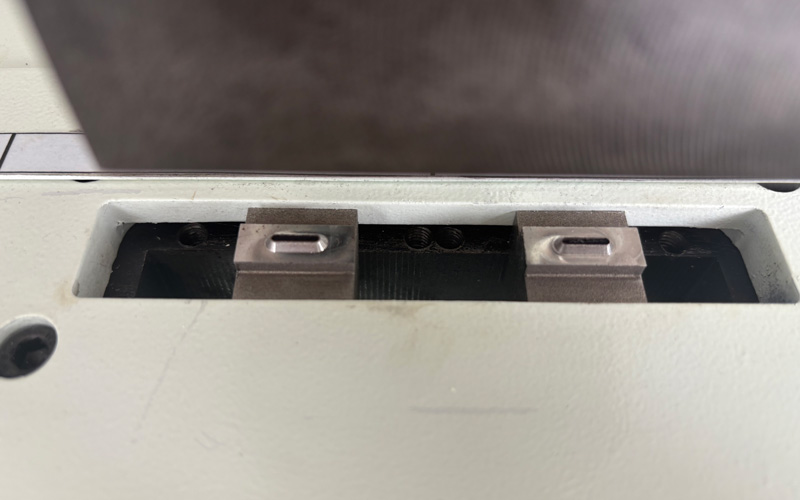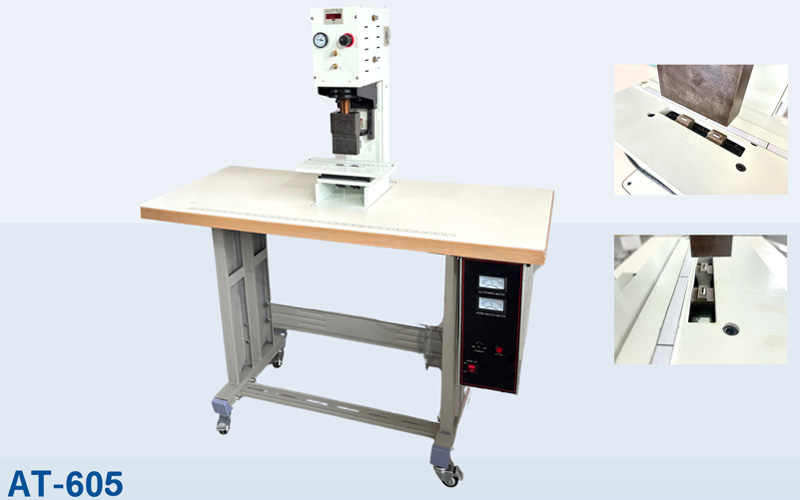In the world of modern garment production, efficiency, accuracy, and fabric integrity are key concerns—especially in the production of high-demand products like polo shirts. Among various process improvements, ultrasonic button holes punching machines are revolutionizing how manufacturers handle buttonhole production.
This article will explore the common challenges faced in traditional buttonhole punching and how ultrasonic technology provides solutions for improved quality, higher productivity, and better fabric preservation, especially for seamless or synthetic polo shirts.
1. Overview: The Role of Buttonhole Punching in Polo Shirt Manufacturing
Buttonholes are a crucial part of polo shirt design, especially for placket closures. Traditionally, punching or cutting buttonholes involved mechanical dies, sharp blades, or heat cutters. These conventional methods present several challenges, especially as fabric types diversify and consumers demand higher quality.
Ultrasonic button hole punching machines utilize high-frequency vibrations to cut, seal, and reinforce buttonhole areas without contact or heat-based scorching.
2. Common Issues in Traditional Buttonhole Processing
Let’s explore the recurring problems manufacturers face with conventional buttonhole punching:
| Issue | Description |
|---|---|
| Fabric Fraying | Edges of the buttonholes often fray after cutting, especially in knit fabrics. |
| Inconsistent Hole Shape | Mechanical methods struggle to maintain consistency in every unit. |
| Burnt or Discolored Edges | Heat cutting can leave brown or yellow edges on polyester or nylon fabrics. |
| Damage to Seamless or Elastic Fabric | Stretch fabrics often tear or distort with punching pressure. |
| Low Efficiency | Manual or semi-automatic processes slow down production and require rework. |
| Poor Stitch Integration | Buttonhole holes do not align with stitching machines perfectly. |
Each of these problems leads to increased rejection rates, poor aesthetics, or compromised garment durability.
3. How Ultrasonic Button Hole Punching Solves These Issues
3.1 No Fraying Due to Seamless Sealing
Ultrasonic punching machines use vibrations (usually around 20–35 kHz) to generate localized friction, melting synthetic fibers along the cut edge. This melting action seals the edges, preventing fraying.
✅ Result: Clean, sealed buttonholes even in loosely knit polo shirt materials.
3.2 Consistent Shape and Placement
Unlike mechanical or manual systems that rely on pressure, ultrasonic punches are digitally controlled, ensuring uniform size and position of every buttonhole.
Suitable for high-precision patterns
Reduces garment rejection due to misalignment
Perfect for symmetrical shirt plackets
🛠️ Digital settings reduce operator error and variability.
3.3 Zero Discoloration or Burn Marks
Since ultrasonic cutting relies on vibration and pressure—not open heat—it avoids charring the fabric.
No scorching on polyester or elastane fabrics
Maintains original fabric color and surface
Ideal for white or light-colored polo shirts
🔥 This is especially useful in premium brands that cannot accept discoloration near buttons.
3.4 Better Compatibility with Seamless & Stretch Fabrics
Seamless garments are made from synthetic, elastic materials that are vulnerable to mechanical stress. Ultrasonic punching avoids tearing or fiber distortion by:
Using non-contact cutting
Applying uniform energy, avoiding fabric deformation
Providing gentle sealing for delicate textiles
💡 Seamless polo shirts, popular in athletic wear, greatly benefit from this method.
3.5 Significant Time Savings and Automation Potential
Ultrasonic machines can be integrated into fully automated production lines. They:
Complete punching and sealing in a single step
Operate at high speed with minimal downtime
Eliminate the need for post-processing (e.g., sealing edges manually)
⚙️ Some factories report 30–50% reduction in buttonhole processing time.
3.6 Enhanced Stitching Integration
Ultrasonic machines can be synchronized with buttonhole stitching equipment via programmable positioning systems, ensuring:
Perfect alignment between hole and stitching
Improved machine compatibility
Less manual adjustment and fewer defects

4. Specific Benefits for Polo Shirt Manufacturers
Polo shirts present unique production challenges. Here’s how ultrasonic punching addresses them:
4.1 Uniformity Across Mass Production
Every shirt must meet consistent standards. Ultrasonic technology ensures repeatable, defect-free output, even at high volumes.
4.2 Aesthetic Superiority
Sealed edges are smoother and flatter, contributing to a high-end look. This matters in fashion retail or branded sportswear.
4.3 Better Compatibility with Sublimation or Printed Fabrics
Heat cutting can distort printed patterns; ultrasonic punching does not. This is ideal for fashion-forward polos with all-over prints.
5. Technical Insights: Why Ultrasonic Works Better
Let’s look at a technical comparison between ultrasonic punching and traditional punching:
| Parameter | Traditional Punching | Ultrasonic Punching |
|---|---|---|
| Cutting Mechanism | Blades or heated dies | Vibrating sonotrode (20–35 kHz) |
| Heat Source | External (electric or flame) | Internal friction via vibration |
| Fabric Compatibility | Limited to firm weaves | Works on synthetic, elastic, and thin knits |
| Edge Finishing | Often frayed or charred | Sealed and smooth |
| Speed | Moderate | High-speed (up to 60 punches/min) |
| Automation | Manual/semi-auto | Fully automated systems available |
| Maintenance Needs | Blade sharpening, die replacement | Minimal maintenance required |
6. Case Study Example: Sportswear Polo Shirt Factory
Factory: GlobalFit Sportswear Ltd.
Problem: High rejection rate (12%) due to fraying in buttonhole area on synthetic polos.
Action Taken: Integrated ultrasonic buttonhole punching machine into the production line.
Results After 6 Months:
| Metric | Before | After Ultrasonic Punching |
|---|---|---|
| Buttonhole defect rate | 12% | 1.5% |
| Production output/day | 4,000 units | 5,800 units |
| Labor required (buttonhole) | 3 workers | 1 operator |
| Maintenance cost (monthly) | $300 | $80 |
✅ Result: Improved quality, lower costs, and faster delivery times.
7. Environmental & Economic Considerations
7.1 Lower Material Waste
Since ultrasonic punching reduces defects and eliminates fraying-related rework, fabric waste is significantly reduced, making it more sustainable.
7.2 Energy Efficiency
While traditional heat cutting consumes electricity for heating elements, ultrasonic machines are energy-efficient, only activating when punching occurs.
8. Integration & Investment Considerations
For manufacturers planning to adopt ultrasonic punching machines, consider the following:
Space requirements: Machines are compact and can be integrated into existing lines.
Operator training: Minimal training required for digital control panels.
Initial cost: Higher than manual systems but offset by reduced defects and higher output.
ROI: Most factories report ROI within 12–18 months, especially at volumes above 1000 shirts/day.
9. Final Thoughts
Ultrasonic button holes punching machines have emerged as an indispensable solution for modern polo shirt manufacturers. From addressing fabric fraying and misalignment to enabling faster, more aesthetic production, these machines offer compelling advantages over traditional methods.
For any factory producing seamless, synthetic, or high-volume polo shirts, the switch to ultrasonic technology is not just an upgrade—it’s a necessity to remain competitive in today’s global market.

10. Summary Table: Common Issues Solved by Ultrasonic Buttonhole Punching
| Common Issue | How Ultrasonic Punching Solves It |
|---|---|
| Fraying of buttonhole edges | Edge sealing through localized melting |
| Inconsistent buttonhole shape | Precision through digital control |
| Burnt or discolored fabric | Non-thermal process eliminates scorching |
| Damage to stretch/seamless fabrics | Non-contact punching prevents tearing or deformation |
| Manual labor & low productivity | High-speed automation with minimal operator intervention |
| Stitch misalignment | Accurate integration with stitching machines |
Need More Info?
If you’re evaluating ultrasonic technology for your polo shirt line, we recommend starting with a trial run or consulting a supplier experienced in garment ultrasonic applications. If you’d like help identifying trusted machine suppliers or getting a custom solution, feel free to reach out.
